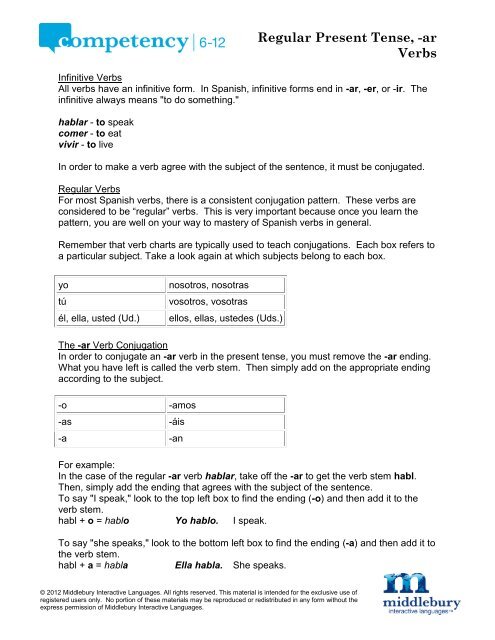Regular Present Tense, -ar Verbs
Regular Present Tense, -ar Verbs Regular Present Tense, -ar Verbs
Regular Present Tense, -ar Verbs Infinitive Verbs All verbs have an infinitive form. In Spanish, infinitive forms end in -ar, -er, or -ir. The infinitive always means "to do something." hablar - to speak comer - to eat vivir - to live In order to make a verb agree with the subject of the sentence, it must be conjugated. Regular Verbs For most Spanish verbs, there is a consistent conjugation pattern. These verbs are considered to be “regular” verbs. This is very important because once you learn the pattern, you are well on your way to mastery of Spanish verbs in general. Remember that verb charts are typically used to teach conjugations. Each box refers to a particular subject. Take a look again at which subjects belong to each box. yo nosotros, nosotras tú vosotros, vosotras él, ella, usted (Ud.) ellos, ellas, ustedes (Uds.) The -ar Verb Conjugation In order to conjugate an -ar verb in the present tense, you must remove the -ar ending. What you have left is called the verb stem. Then simply add on the appropriate ending according to the subject. -o -amos -as -áis -a -an For example: In the case of the regular -ar verb hablar, take off the -ar to get the verb stem habl. Then, simply add the ending that agrees with the subject of the sentence. To say "I speak," look to the top left box to find the ending (-o) and then add it to the verb stem. habl + o = hablo Yo hablo. I speak. To say "she speaks," look to the bottom left box to find the ending (-a) and then add it to the verb stem. habl + a = habla Ella habla. She speaks. © 2012 Middlebury Interactive Languages. All rights reserved. This material is intended for the exclusive use of registered users only. No portion of these materials may be reproduced or redistributed in any form without the express permission of Middlebury Interactive Languages.
<strong>Regul<strong>ar</strong></strong> <strong>Present</strong> <strong>Tense</strong>, -<strong>ar</strong><br />
<strong>Verbs</strong><br />
Infinitive <strong>Verbs</strong><br />
All verbs have an infinitive form. In Spanish, infinitive forms end in -<strong>ar</strong>, -er, or -ir. The<br />
infinitive always means "to do something."<br />
habl<strong>ar</strong> - to speak<br />
comer - to eat<br />
vivir - to live<br />
In order to make a verb agree with the subject of the sentence, it must be conjugated.<br />
<strong>Regul<strong>ar</strong></strong> <strong>Verbs</strong><br />
For most Spanish verbs, there is a consistent conjugation pattern. These verbs <strong>ar</strong>e<br />
considered to be “regul<strong>ar</strong>” verbs. This is very important because once you le<strong>ar</strong>n the<br />
pattern, you <strong>ar</strong>e well on your way to mastery of Spanish verbs in general.<br />
Remember that verb ch<strong>ar</strong>ts <strong>ar</strong>e typically used to teach conjugations. Each box refers to<br />
a p<strong>ar</strong>ticul<strong>ar</strong> subject. Take a look again at which subjects belong to each box.<br />
yo nosotros, nosotras<br />
tú vosotros, vosotras<br />
él, ella, usted (Ud.) ellos, ellas, ustedes (Uds.)<br />
The -<strong>ar</strong> Verb Conjugation<br />
In order to conjugate an -<strong>ar</strong> verb in the present tense, you must remove the -<strong>ar</strong> ending.<br />
What you have left is called the verb stem. Then simply add on the appropriate ending<br />
according to the subject.<br />
-o -amos<br />
-as -áis<br />
-a -an<br />
For example:<br />
In the case of the regul<strong>ar</strong> -<strong>ar</strong> verb habl<strong>ar</strong>, take off the -<strong>ar</strong> to get the verb stem habl.<br />
Then, simply add the ending that agrees with the subject of the sentence.<br />
To say "I speak," look to the top left box to find the ending (-o) and then add it to the<br />
verb stem.<br />
habl + o = hablo Yo hablo. I speak.<br />
To say "she speaks," look to the bottom left box to find the ending (-a) and then add it to<br />
the verb stem.<br />
habl + a = habla Ella habla. She speaks.<br />
© 2012 Middlebury Interactive Languages. All rights reserved. This material is intended for the exclusive use of<br />
registered users only. No portion of these materials may be reproduced or redistributed in any form without the<br />
express permission of Middlebury Interactive Languages.
Let’s look at all the present tense conjugations for habl<strong>ar</strong>:<br />
<strong>Regul<strong>ar</strong></strong> <strong>Present</strong> <strong>Tense</strong>, -<strong>ar</strong><br />
<strong>Verbs</strong><br />
yo hablo nosotros/nosotras hablamos<br />
tú hablas vosotros/vosotras habláis<br />
él/ella/usted habla ellos/ellas hablan<br />
The <strong>Present</strong> <strong>Tense</strong><br />
The <strong>Present</strong> <strong>Tense</strong> in Spanish is usually used to talk about an action that is happening<br />
now, but it can also mean two slightly different things.<br />
In the case of the verb habl<strong>ar</strong>, it can mean:<br />
yo hablo I speak<br />
yo hablo I am speaking<br />
yo hablo I do speak<br />
Note: Since the verb changes to match the subject of the sentence, it is possible to<br />
leave the subject pronoun out of the sentence entirely. In fact, it is very common among<br />
native speakers.<br />
For example, instead of saying yo hablo (I speak) you can just say hablo.<br />
-AR <strong>Verbs</strong> © 2012 Middlebury Interactive Languages. Page 2



